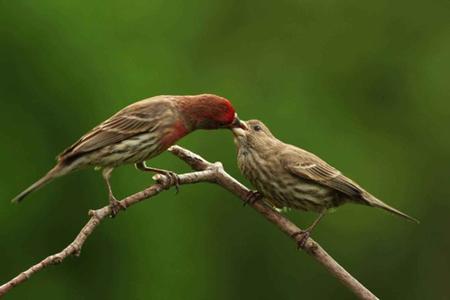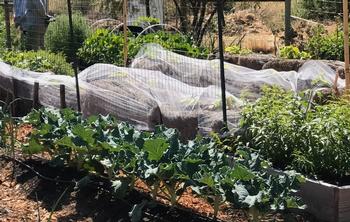News from the Edible Demo Garden
May 2023: Sharing the Garden with Birds

Birds are both garden friends and garden pests. It’s hard to imagine a thriving garden without them. They can do a lot of good in ridding the garden of harmful insects and weeds. The damage they do to plants is just a consequence of their efforts to survive and feed their young. Sometimes the damage is minimal. A few bites out of the leaves of mature plants or an occasional peck marked pear can be tolerated. But when the losses increase, tolerance wanes.
Controlling bird damage in the garden
The primary bird deterrent options for home gardeners are scare tactics and exclusion. The goal is to redirect rather than harm the birds.
- Scare tactics - Shiny objects or noisemakers can frighten birds away from garden crops. Fake predators like plastic owls or hawks and snakes are also deterrents. Visual scare devices are more effective when combined with sound. Because birds are smart and will become accustomed to scare tactics, these need to be varied and changed regularly. The classic scarecrow in the corn field is unlikely to keep fooling birds for long.
- Exclusion – Netting has proven to be the most effective method for controlling bird damage in the Edible Demo Garden. Tulle fabric is an inexpensive fine mesh netting that works very well to protect seedlings and newly seeded beds from hungry birds. It is draped over metal hoops and allows both sun and water to penetrate. Once plants begin to flower, however, the tulle needs to be removed to allow access to pollinators. Usually by then the plants have become less tempting for the birds.

Individual plant covers are another exclusion option. Plant cloches are domed wire or plastic cages, open on the bottom and designed to fit over a single plant or group of plants. These can be purchased or made from chicken wire, plastic jugs, or other recycled containers. A fruit tree can be enclosed in netting or paper bags can be secured over the ripening fruit.
The ideal solution for preventing bird damage would be fully enclosed garden beds. Lacking that, most gardeners opt for one or more of the methods described and resign themselves to sharing a little of their produce with the birds. The squash and cucumbers have been replanted in the straw bales. This time they are protected with tulle.
